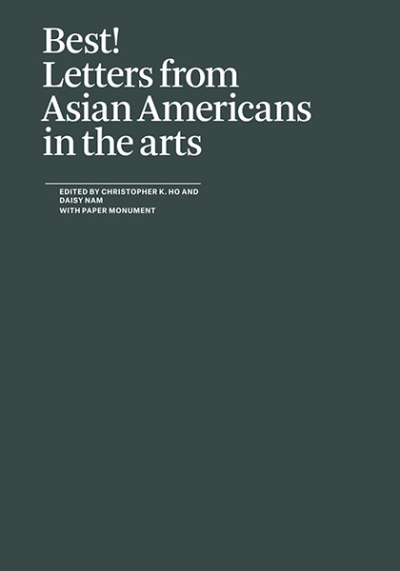[ad_1]
“Sitting down to write a letter, with an addressee and signatory, is an intimate experience,” editors Christopher K. Ho and Daisy Nam write in the introduction of Best! Letters from Asian Americans in the arts. The pretext is deceptively simple: Ho, a visual artist, and Nam, a curator, invited Asian Americans, loosely defined, working across the arts to write letters exploring the racial tensions that underlie their personal and artistic lives, to examine their culture on their own terms. The result is a gorgeous display of the diversity of lived experiences of art workers who fall imperfectly under the “Asian American” identifier.
Several themes emerge naturally: the strange feeling of being in between cultures, of not truly belonging anywhere, the myth of the model minority, the desire to interrogate how Asian Americans understand and can fight against white supremacy, the pain of intergenerational trauma wrought by war, poverty, and racism. Cathy Park Hong’s Minor Feelings, a revelatory book exploring the racialized feelings of shame and invisibility that Asian Americans often experience in white supremacist culture, is a frequent reference. (Hong is also a contributor to this book.) If there is one overarching through line, it is one of reckoning. Written primarily in the months leading up to the 2020 U.S. presidential election, as President Trump spread xenophobia with his “Chinese Virus” tweets, hate crimes against Asian Americans increased, and people around the globe protested in support of Black lives, the moment was ripe for questioning culture and one’s role in it.
The number of writers grappling here with where they fit in, not feeling Asian enough with Asians, or American enough with non-Asian Americans, raises serious questions about how people get tracked into racial categories. Artist Josh Kline’s letter, addressed “To whom it may concern,” acutely highlights the frustration of claiming a certain identity. On paper, he’s often assumed to be a “White Jew,” in person, he’s often taken for Latino. Like many Americans, his parents have roots in several countries: his father is of broadly European Jewish descent and his mother is from the Philippines. “Mixed-race identities are complicated … for people who carry or cling to certain ideas, assumptions, or theories about racial and cultural purity. And for Americans,” he writes, pointing out the absurdity of whiteness as an “imagined absolute in the United States.” He continues: “I wish you could understand that these apparent contradictions many of you get hung up on are artificial constructs, like the ideas of racial and cultural purity that people who are in love with sick racial myths rooted in colonial imperialism and slavery cling to.”
Art administrator and curator Holly Shen, who is white, Jewish, and Chinese, also touches upon this in her letter, writing, “The convention of assigning racial percentages to individuals is absurd yet crucial to the understanding of contemporary identity; the practice defines an individual with irrevocable, often violent force.” Artist Anicka Yi puts it another way, writing succinctly that “Identity is the cop of culture.” By that, she means that when we are too tied to our identities: as a white person, as a feminist, as a member of the intellectual class, etc, then it’s hard to see outside of that framework.
To that end, many writers also interrogate the concept of the model minority, which contributor Marc Handelman points out has roots in anti-Black rhetoric. Handelman’s reference is to a 1966 New York Times article “lauding the ‘success story’ of Japanese Americans rebuilding their lives into model citizens after internment.” This would have been published just after the 1965 Immigration and Nationality Act, which put an end to earlier Asian immigration quotas. The model minority myth, and which Asians it extends to—mostly East Asians, often working in math or science, medicine or tech—is another factor complicating notions of identity, and how the U.S. uses these identity markers for political gain. See the way Chinese immigrants were literally banned from entry in 1882, while today the U.S. grants around four out of every five H-1B visas to highly-skilled workers from India or China.
In a letter to her younger sister, art history professor Marci Kwon discusses the double-edged sword of the model minority, particularly for second- and third-generation folks, whose forebears need(ed) to believe that money equals safety, that hard work would be enough to access the American dream. “This is how the model minority myth operates: we take society’s racist message—be more perfect, be more White—and when we fail, we blame ourselves,” Kwon writes. “It is easier to do this, to pretend we have some measure of control, than face the truth that the game is of course rigged: it is as impossible to achieve perfection (perfect for whom?), as it is for an Asian person to become White.”
Other pieces take aim at the racism and tokenism embedded in the art world. In a stinging letter to Mike Eckhaus and Zoe Latta, architect Philip Poon chastises the designers for the “aesthetic fetishization” of their store locations in both New York and LA’s Chinatowns. The edgy brand, which is known for casting diverse models in their campaigns, tends to appeal to exactly Poon’s demographic, as he puts it, “an art-adjacent millennial who lives in Brooklyn.” He’s speaking their language. “I mean, we get it right? The contrast between high and low, edgy and basic, cool and Chinese … I get it,” he writes. Yet the Chinese vendors near Eckaus Latta’s stores, the Chinese people in the background of their photos are people too, Poon notes, not props to be used to lend a level of grittiness to their high fashion. He questions why the fashion world still accepts such exotification of Asians, while treating other racial groups that way would now be unthinkable.”
The book also has plenty of moments of levity—I particularly enjoyed curator Howie Chen’s contribution, a list of greetings to questionable Asian American public figures, from Andrew Yang to Priscilla Chan to Tila Tequila, followed by a two-word message: Good luck. Writer Dawn Chan pontificates on the ubiquity of strangers including “purple people” when debating race on the internet. Artist Mary Lum, writes to the late artist Ray Yoshida on the experience of going through his archives, and the poetry gleaned from his notes and ephemera. Ka-man Tse, like several other contributors, writes a beautiful series of letters to her child, then seven months old, reflecting on parenthood and the world that seems to be changing by the day. Journalist Jia Tolentino, seven months pregnant, reckons with the realization that much of her personal striving to open up access for others would have had a greater effect if it was done more collectively. “As with everything, as with anything, the promise comes in remembering you’re not alone, never alone, never first, never last, never singular,” she writes.
The last two entries are a feat in editing, having surely been chosen to knock you flat on your back. First, in a long email, artist Asad Raza writes to loved ones about the harrowing journey he has just been on witnessing the birth of his first child, which did not go as planned. (Happily, by the end of the letter, you learn that mother and child are both ok.) Raza writes breathlessly in the manner that only new parents can, as they experience the jolt of pure joy that comes from bringing a new life into the world. “I don’t remember crying from happiness before, and now I do it every time I see her,” Raza writes of the baby, now two days old. “Life has changed. It’s hard to remember it exactly before Sunday, which is partly why I wrote this down.” In that vein, designer Chris Wu’s letter to his child follows, and includes a short, gut-punch of a handwritten note from his parents, meant as advice for a successful relationship. (I won’t spoil with more specifics.) Every generation probably looks at bringing children into the world as an act of embodying hope, of betting on the fact that there will be a better future world for them to experience. Thus, it makes perfect sense that so many letter-writers here conjure intergenerational bonds, pledging to make the world more just for the next generation. Offering these as letters lets the writers think as expansively as they want, dropping hints that can turn into possibilities, that can fire our neural networks into new and exciting configurations. As Ho and Nam put it in their introduction, “In the gap between writing and receiving, there’s space for dreaming—and for change.”

Nonfiction
Best! Letters from Asian Americans in the arts
Edited by Christopher K. Ho and Daisy Nam
Paper Monument
Published April 13, 2021
[ad_2]
Source link
